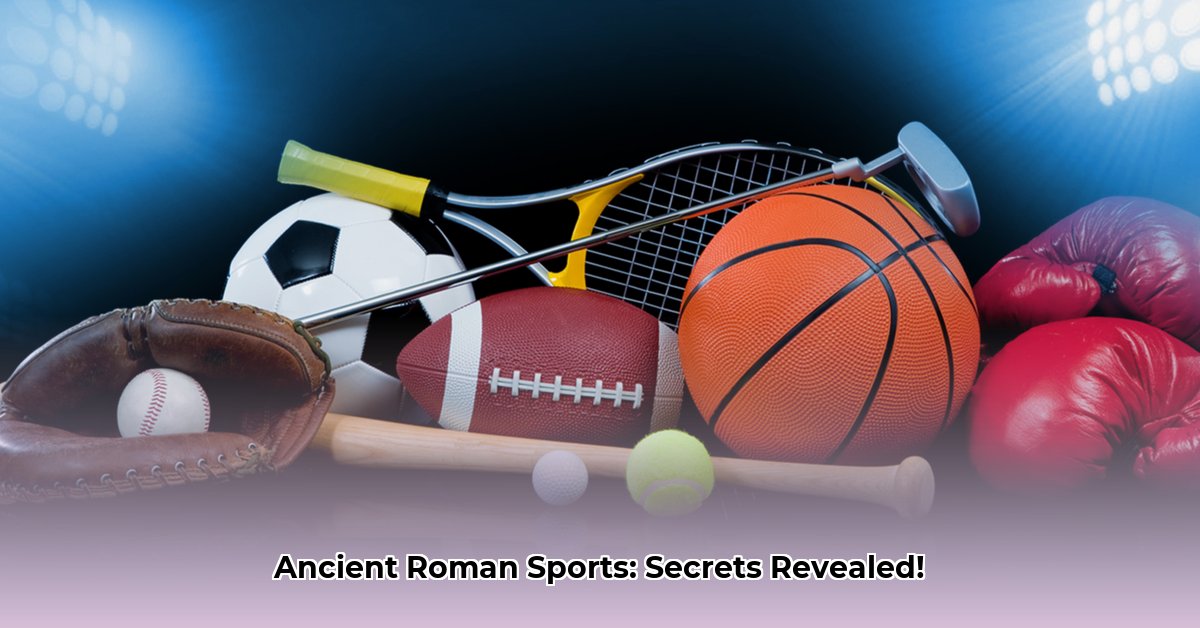Ever wondered what truly ignited the passion of ancient Romans beyond their vast empire? Beyond emperors and legions, sports were incredibly significant. It wasn’t just about gladiators locked in brutal combat, though that was certainly a centerpiece. From heart-stopping chariot races and intense wrestling matches to surprisingly engaging ball games, the Romans cultivated a rich sporting landscape that profoundly shaped their entire civilization. Forget dry historical accounts; we’re diving deep into the multifaceted world of Roman sports, uncovering everything from the iconic gladiator showdowns to the lesser-known games and their enduring relevance today. Prepare to discover an exhilarating new dimension of the Roman Empire!
The Grand Spectacle: Mainstays of Roman Public Entertainment
Were the games of ancient Rome merely a pastime, or did they hold much deeper significance for society? They were far more than simple entertainment; these events played a vital role in unifying Roman society and projecting the empire’s immense power. Emperors and affluent citizens clearly understood this, frequently staging magnificent public games, known as ludi, to curry favor with the populace and grandly display imperial wealth. These spectacles were critical for maintaining public morale and political stability across all social strata.
Chariot Racing: The Roar of the Circus Maximus
Imagine this scene: tens of thousands of spectators packed into the colossal Circus Maximus, the air thick with electrifying anticipation. The roar of the crowd was deafening as chariots thundered around the track, the very ground shaking beneath the powerful horses’ hooves. These events were not just races; they were breathtaking spectacles of pure speed, incredible skill, and often, deadly collisions. The factiones, or teams—Blue, Green, Red, and White—each identified by a distinct color, inspired fervent loyalty among their devoted fans. This allegiance sometimes escalated into violent street brawls between rival supporters, underscoring just how profoundly these sporting events were woven into Roman life. Could you envision rivalries so intense they sparked riots? This illustrates the profound societal influence of these high-stakes competitions.
A typical race consisted of seven laps around the spina, the central dividing barrier within the circus, and would last approximately fifteen minutes. Chariots reached speeds of up to 30 miles per hour on straightaways. Charioteers, often small in stature like modern jockeys, tied the reins around their hands for control, carrying a dagger to cut themselves free in case of a crash, known as naufragia. Despite the perilous risks, successful charioteers achieved unparalleled fame and considerable wealth, becoming the superstars of their day.
Gladiatorial Combat: Artistry, Brutality, and Imperial Power
Gladiatorial combat, which originated as a solemn Etruscan funerary ritual, evolved into an extraordinarily popular form of entertainment. However, it was not simply mindless violence. Gladiators, who were often slaves, prisoners of war, or even volunteers seeking glory, received specialized, intensive training in dedicated fighting schools called ludi (singular, ludus).
Inside the Ludus: Forging Warriors for the Arena
Stepping inside a ludus was to enter a veritable crucible. These specialized schools rigorously molded ordinary individuals into extraordinary fighters. Gladiator training was a comprehensive and holistic process, meticulously blending intense physical conditioning and mental fortitude with highly specialized combat skills. This rigorous system ensured they were prepared for the arena’s demands.
Recruits endured relentless physical training designed to build formidable strength and remarkable stamina. They practiced continuously, tirelessly honing their skills with stout wooden weapons, which were often intentionally heavier than the ones they would wield in the actual arena. The palus, a sturdy wooden post, served as their primary practice dummy. Gladiators would relentlessly strike it, meticulously developing their technique and building crucial muscle memory. Experienced gladiators regularly sparred with one another, pushing their limits and refining their individual fighting styles, each uniquely tied to their specific weapons and armor.
The doctor, or magister, was far more than just a trainer; they functioned as pivotal mentors and astute strategists. Usually former gladiators themselves, they possessed an intimate understanding of every nuance of combat. They diligently taught recruits the specific fighting styles associated with different gladiator types, such as the heavily armored murmillo with his large shield and short sword, the agile retiarius fighting with a net and trident, or the Thracian with his curved sword and small shield. Their primary goal was not merely preparing gladiators to survive, but to survive with captivating flair.
What did gladiators actually consume? A diet predominantly rich in grains and various beans. This dietary staple earned them the enduring nickname hordearii, meaning “barley-eaters.” This specific diet provided them with the sustained carbohydrates necessary for intense physical activity; it also afforded them a slight layer of extra padding. Some historical sources suggest that a marginally higher body fat percentage was actually considered beneficial, potentially offering additional protection during the brutal combat.
Life within the ludus was strictly governed by rigid rules and often enforced by harsh punishments. Discipline was considered absolutely essential, but so too was a strong sense of camaraderie. The familia gladiatoria formed a remarkably close-knit community where gladiators resided, trained, and ultimately fought alongside each other. This unique bond fostered deep loyalty and mutual support, though fierce competition for status and recognition remained ever-present. Some skilled or particularly fortunate gladiators could achieve significant fame and wealth, with a rare few even earning their freedom after many years of dedicated service. Their enduring legacy inspires historical reenactors, fitness enthusiasts, and dedicated archaeological researchers even today.
Boxing and Wrestling: Raw Strength and Strategic Skill
Roman sports extended significantly beyond the blood-stained sands of the Colosseum. Boxing (pugilatus) and wrestling challenged competitors’ raw strength and remarkable endurance. Roman boxing, fought with minimal protection like himantes (leather straps wrapped around the hands leaving fingers free), was exceptionally brutal, favoring those with an extraordinary capacity to withstand pain. Unlike modern boxing, there were no weight classes or “rounds”; matches continued until one participant yielded or became incapacitated.
Wrestling, commonly practiced in specialized gymnasia (palaestrae), skillfully combined formidable physical power with astute strategic thinking. These sports tested the strength, endurance, and technique of athletes, drawing crowds eager to witness the raw physicality of the contestants as they battled for supremacy. They also played a crucial role in reinforcing the warrior ethos central to Roman culture.
| Sport | Description | Social Impact |
|---|---|---|
| Chariot Racing | High-speed races in the Circus Maximus featuring teams that represented distinct social factions. | Fostered extreme fan rivalries, acted as a significant political instrument, and could either unite or divide public sentiment. |
| Gladiatorial Combat | Armed battles between highly skilled fighters, frequently enslaved individuals or convicts. | Embodied Roman military ethics, showcased imperial authority, and offered unique social opportunities for successful warriors. |
| Boxing (Pugilatus) | A brutal fighting sport involving minimal protection, placing a premium on stamina and resilience. | Tested the absolute limits of physical fitness, demonstrating a high appreciation for aggression and physical dexterity. |
| Wrestling | Practiced in specialized halls, demanding both significant physical skill and strategic capacity. | Contributed to Roman martial values, actively promoted physical health, and encouraged discipline. |
Beyond the Arena: Diverse Athletic Pursuits
Ancient Roman society masterfully balanced demanding work (negotium) with essential leisure (otium). While many immediately think only of gladiators, the Roman sports scene was surprisingly diverse, encompassing a wide array of activities enjoyed by all social classes.
Ball Games: Play, Agility, and Social Interaction
Then there were the lively ball games. Harpastum, a rough-and-tumble sport that resembled a dynamic mix of rugby and handball, demanded impressive agility and cohesive teamwork. It involved two teams attempting to move a small ball, about eight inches in diameter and stuffed with sand or hair, across the opposing team’s baseline on a rectangular field. While the precise rules remain somewhat elusive, historical evidence strongly suggests it was a widely popular leisure activity among both friends and soldiers. Unlike the colossal public spectacles, harpastum offered a more intimate and participatory sporting experience.
Simpler games like trigon and follis were enjoyed more casually. Trigon involved three players passing a ball with speed and accuracy, while follis was akin to a volleyball game with a larger, softer ball. Played in city streets, public baths, or open fields, these games provided both invigorating physical activity and vital social interaction. Some historians believe these games were crucial for maintaining public health and bolstering morale across all social strata, and may have even served as a form of military training.
Everyday Athletics: Swimming, Riding, Hunting, and More
Romans engaged in a remarkably wide array of athletic activities beyond these iconic “big three” and ball games. Swimming was a favorite activity, particularly in the Tiber River next to the Campus Martius, a vast floodplain that served as a playground for Rome’s youth. Most Roman baths also included plunge pools for swimming. Horseback riding was a preferred activity for Roman boys from a young age, as every Roman was expected to be a good equestrian. Competitive running, jumping, and throwing were also common on the Campus Martius. Hunting was a popular sport among the Roman elite, often undertaken with their sons to teach marksmanship, while fishing was a favored pastime in the countryside. These activities contributed to the overall physical fitness and well-being of the Roman populace.
The Architecture of Spectacle: Roman Sporting Venues Development
Roman society undeniably prioritized substantial investment in a diverse range of sporting and spectacle venues. These architectural marvels evolved progressively from temporary structures to impressively permanent, complex complexes. They powerfully symbolized Roman might, reinforced intricate social hierarchies, and solidified core cultural identity. Furthermore, the specific types of venues heavily influenced the kinds of activities that could be hosted within them. The innovative use of concrete allowed for the construction of increasingly larger and more structurally complex designs.
For the Romans, sports were never merely a pastime; they were inextricably ingrained as a fundamental aspect of their civilization. It served as a grand theater for demonstrating imperial power, a vivid display of social strata, and a genuine mirror reflecting their profound cultural ethos. From the thunderous roar echoing through the Colosseum to the exhilarating thrill of the Circus Maximus, these venues were far more than simply structures; they were the pulsating hearts of Roman society.
Amphitheaters: Stages of Life and Death
Consider the Colosseum’s imposing grandeur. Amphitheaters were purpose-built specifically for gladiatorial contests, elaborate beast hunts (venationes), public executions, and even simulated naval battles (naumachiae) when the arena was flooded. These magnificent arenas served as a dramatic stage for showcasing immense courage, remarkable skill, and, quite often, brutal, definitive endings. The sand-covered arena floor was not merely for aesthetic purposes; it efficiently absorbed the blood spilled in honor of the games, a stark reminder of the visceral drama. The Colosseum itself could accommodate up to 50,000 spectators, a testament to Roman engineering and the sheer popularity of these spectacles.
Circuses: Thrills on the Track
Now, visualize the vast expanse of the Circus Maximus. Emperor Trajan’s reign saw its capacity reach an astounding 250,000 people, making it the largest stadium of its kind in the ancient world. Imagine the synchronized thunder of hooves and the deafening roar of the crowd as charioteers risked both life and limb in their relentless pursuit of glory. These events were not just races; they were high-stakes dramas meticulously played out before a captivated, massive audience. The spina, that prominent central barrier adorned with monuments and laps markers, was not just a simple divider; it was the dynamic focal point of all the action, where fortunes were simultaneously won and irrevocably lost.
Palaestrae and Gymnasia: Training Grounds for Body and Mind
Beyond the main public spectacles, wealthy Romans often incorporated private gymnasia, or palaestrae, directly into their opulent villas for personal training. Public bath-gymnasium complexes were also ubiquitous. These versatile places were not solely dedicated to personal hygiene; they functioned as vital centers for athletic training and dynamic social interaction, directly mirroring the strong Greek emphasis on physical fitness. It was here that athletes honed their skills, built strength, and engaged in intellectual discussions, embodying the Roman ideal of a sound mind in a sound body. These institutions contributed to the development of well-rounded individuals ready to serve as both citizens and competitors.
| Roman Sporting Venues | Purpose | Key Features / Capacity |
|---|---|---|
| Amphitheaters | Gladiatorial combats, public executions, animal hunts | Oval structures, seating tiers, sand-covered arena, underground chambers. Colosseum seated 50,000. |
| Circuses | Chariot races, equestrian displays | U-shaped tracks, central spina, starting gates (carceres), lap counters. Circus Maximus seated up to 250,000. |
| Stadia | Athletics (running, jumping, throwing) | Rectangular courses, often smaller than circuses, sometimes part of larger complexes. Example: Domitian’s Stadium (Piazza Navona). |
| Bath-Gymnasium Complexes | Exercise, bathing, socializing | Public and private facilities with pools, exercise yards (palaestrae), saunas, libraries. |
The Greek Connection: Adaptation and Amplification
The ancient Greeks exerted a significant influence on Roman sports, particularly in their emphasis on physical fitness and organized athletic competition. Romans enthusiastically embraced and skillfully adapted these Hellenic traditions, seamlessly integrating them into their uniquely Roman sporting culture. The origins of boxing, harpastum, and even some forms of chariot racing can be traced back to Greek practices.
However, the Romans were far from mere imitators. They dramatically amplified the spectacle, making everything grander and far more dramatic. Roman chariot races, for instance, were considerably longer, featured more chariots per race (up to 12), and were inherently more dangerous than their Greek predecessors. Emperor Nero, a noted Hellenophile, played a pivotal role in popularizing Greek-style athletic games, known as Neronia, which included boxing and wrestling, further merging Greek ideals with Roman grandeur. This creative adaptation resulted in distinctly Roman pastimes that captivated their entire culture and underscored their imperial might.
Unveiling the Past: Reconstructing Ancient Roman Sports
While iconic images of gladiators and chariot races dominate our perception of ancient Roman sports, the task of fully understanding the diverse range of athletic endeavors requires meticulous investigation. How do we reconstruct lesser-known Roman sports? This endeavor demands a multi-faceted approach, combining meticulous archaeological studies, rigorous historical analysis of ancient texts, and innovative experimental archaeology to bring these pastimes back to life.
Archaeologists and historians work tirelessly to piece together the complex puzzle of Roman sporting venues and activities. Excavations have uncovered ancient stadiums, gymnasiums, and amphitheaters like the Colosseum and Circus Maximus, shedding light on the scale and organization of these traditions. Artifacts such as inscriptions commemorating victorious athletes, statues depicting boxers and wrestlers, and intricate mosaics illustrating ball games and hunting scenes provide invaluable visual evidence.
However, many details remain elusive. For a sport like harpastum, described by ancient authors like Sidonius Apollinaris and Galen, literary accounts offer tantalizing clues about its objective and general play. Yet, the precise rules—such as the exact number of players, the duration of matches, or the specific role of a “middle player” (medicurrens)—are not fully detailed. Researchers must interpret fragmented texts, compare them with related Greek games, and sometimes engage in experimental archaeology by re-enacting the games based on their best interpretations. This “trial-and-error” approach helps to understand the practicalities and challenges of playing these ancient sports.
For Roman boxing, details from statues like the Terme Boxer and descriptions of himantes provide insights into its brutal nature and equipment. But the lack of modern concepts like weight classes or defined rounds makes a direct comparison challenging. Reconstructing Roman boxing involves understanding ancient leather-working techniques for the himantes, analyzing potential athlete diets for muscle development, and meticulously examining match day conditions within their specific venues.
For a deeper dive, explore this piece on Roman sporting life.
Current research continues to uncover fascinating new details about sports in ancient Rome, and our understanding of their profound importance is consistently evolving. Archaeologists and historians are diligently analyzing artifacts, ancient texts, and other forms of evidence to shed further light on this captivating aspect of Roman civilization. This ongoing effort allows us to not only appreciate the grandeur of the Roman Games but also to understand the daily athletic pursuits that shaped the lives of ordinary Romans.
The sporting world of ancient Rome offers a vivid, illuminating lens through which to examine Roman society. From the magnificent displays of gladiatorial contests to the more intimate pursuits of ball games, sports fundamentally shaped social interactions, intricate political maneuvering, and core cultural values. Roman sports undeniably left an indelible mark, profoundly shaping modern sports, influencing the very Olympic Games, dictating stadium design, and even defining the concept of the professional athlete. Studying these ancient sports offers vital insights into Roman culture, society, and core values, reinforcing their enduring relevance in understanding the comprehensive evolution of sports and society.










